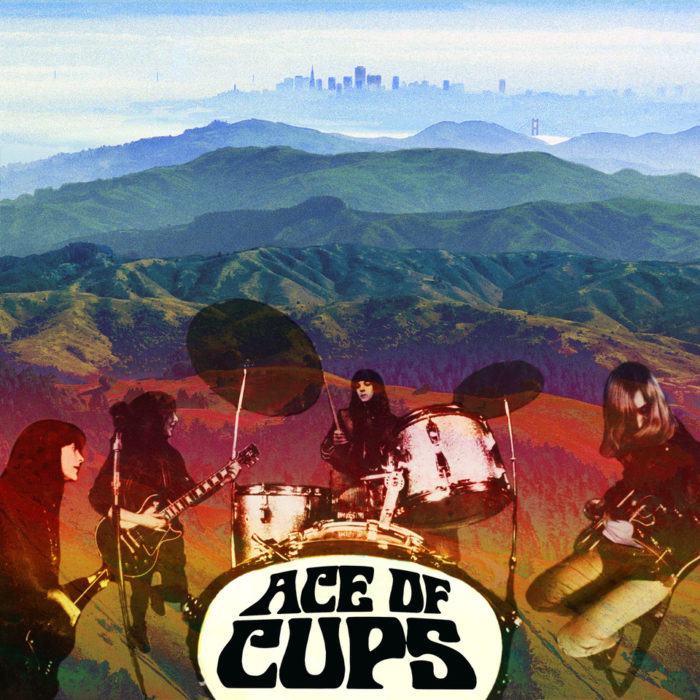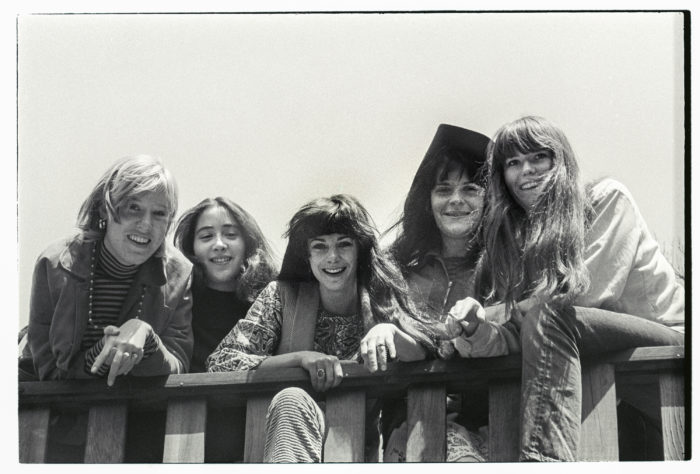Track By Track: Ace of Cups

photo by Rachael Wright
“Back then, the record labels might have thought that a woman could front a band—it obviously worked with Janis and Grace—but that was as far as their imaginations would go,” reflects Denise Kaufman of her pioneering all-female Bay Area group Ace of Cups, who are finally releasing their eponymous debut studio album more than 50 years after they first gained notoriety. “The labels assumed that fans wanted cute guys in the band because that’s who the screaming girls came to see. So whether it was misogyny or not, they thought a girl band wouldn’t sell. That was the record labels’ mentality.”
Ace of Cups, which featured Marla Hunt (keyboards/ vocals), Mary Gannon (bass/ vocals), Mary Ellen Simpson (lead guitar/vocals), Diane Vitalich (drums/vocals) and Kaufman on vocals and harmonica, earned the respect of their San Francisco peers while sharing bills with the Grateful Dead, Jefferson Airplane, Santana and The Band. The quintet also delivered a legendary performance on the back of a flatbed truck in Golden Gate Park’s panhandle, opening for Jimi Hendrix a week after his appearance at Monterey Pop. (Hendrix, who Kaufman recalls was taking photos during their set, later told Melody Maker: “I heard some groovy sounds last time in the States, like this girl group, Ace of Cups, who write their own songs and the lead guitarist is, hell, really great.”)
In 1968, Ace of Cups performed on West Pole, a television special produced by Ralph Gleason, the longtime San Francisco Chronicle music critic and Rolling Stone co-founder, alongside a roster that included the Dead, the Airplane, Steve Miller Band, Quicksilver Messenger Service and Sons of Champlin.
Despite all this acclaim, Ace of Cups could not secure a record contract. As Kaufman recalls, “I don’t think we were even close. No one even wanted to have a meeting with us.” By 1972, with some of the members raising children, the group dissipated. “We weren’t financially successful enough to afford nannies for our kids,” Kaufman adds. “Also, when the kids were little, we were nursing, so we didn’t want to be away for too long. Those were real circumstances that created certain limitations to what we could do.”
Ace of Cups retained cult status for many years, then High Moon Records president and co-founder George Wallace approached them and provided the impetus to record their first-ever studio album. He initially hoped to discuss an archival release, before deciding to enlist producer Dan Shea to work with the band. (Marla Hunt opted not to participate, and Kaufman observes, “We had different creative leanings. She’s been doing stuff with her husband, and it seemed to work better for her to follow her own path.”)
Kaufman hails Shea for his vision and passion, helping to craft a double album that includes guest appearances by Bob Weir, Taj Mahal, Jorma Kaukonen, Jack Casady, Charlie Musselwhite, David Grisman, Pete Sears, Steve Kimock, Buffy Sainte-Marie and Peter Coyote.
Here, Kaufman walks through Ace of Cups’ first record of the two-disc set.

FEEL GOOD
Since we never were able to record in a studio, we didn’t have much in the way of tapes other than the West Pole TV show and a concert at the New Orleans House where Hot Tuna was recording a live album. Most of the recordings we have of the band were made at our rehearsal studio, so we could listen afterward and critique ourselves in order to see what worked and what didn’t.
Then, right around the time the original Ace of Cups live album came out [in 2003], I got an email from John Addie, who told me that he had gone to this concert in Seattle and brought his tape recorder. He was a big Jefferson Airplane fan, and we were opening for them and, somewhere in the middle of the set, he decided, “That sounds pretty good. I think I’ll turn my tape recorder on.” So he recorded that song and a couple other things, and he tracked me down and said, “I’ve been waiting 40 years to send this to you. I didn’t know how to reach you.” He made a CD of it and sent it to me; it was the most terrible-quality recording, but this song was on it and there was more of it than we remembered. That’s how we ended up recording it.
Jack [Casady] played bass, so it seemed like a circle coming around because we had done that Northern tour with the Airplane and we sang on their Volunteers album. Jack was so generous. I had already recorded all the bass parts for the songs that he ended up playing on, and he called me from his home in England to ask, “Are you OK with me bouncing you off these tracks?” And I was like, “I’m totally OK with it. Thank you so much for wanting to play on our album—we’re honored and thrilled.” That’s how thoughtful a person he is.
PRETTY BOY
This song was inspired by Mary Ellen’s crush on Dickie Peterson from Blue Cheer. I can never hear this song without thinking about Mary Ellen longing for him in those early days. Dan Shea brought some really cool, funky grooves to it that have been really fun to explore, musically. Now it’s deeper in the pocket, whereas
the original way that we did it was more straight-ahead rock. I’m a big fan of repeating lines and harmonies that fit like counter-melodies, and that’s one of the things that I love about that song. I also love Mary Ellen’s angst when she sings, “No other woman could love you like I do.”
FANTASY 1 & 4
There was a tape I made and sent to Ralph Gleason in late-‘67, early-‘68 because sometimes I’d record on a little reel-to-reel at home and send him things I was working on. There were five or six songs on this tape, none of which we ended up doing in Ace of Cups. I didn’t have a copy of those songs and, after Ralph died, that tape ended up in the vaults at Fantasy Records because Ralph was working with Saul Zaentz at Fantasy.
Eventually, that tape somehow found its way to Dan Shea, and he called me up and said, “What about these songs that were in the Fantasy vault?” And I’m like, “I don’t know what you’re talking about.” So he sent me some tracks, and I hadn’t heard those songs since I recorded them.
“You Don’t Understand” is going to be on our next CD. Then there was another song where we loved the melody but it needed a bridge. So we took the bridge that we loved from another song and I wrote new lyrics for it. So we basically combined two songs, and we called it “Fantasy 1 & 4” because it came from Fantasy and it was tracks one and four. That title also fit the lyrics. “I’ve got my compass and my dreams” is a key line that I enjoy singing, and I like people, especially young girls, thinking that. When we do it live, we usually do a longer jam on those lines.
CIRCLES
We played “Circles” a lot in Ace of Cups. I wrote it and I love that Diane sings it because she’s great at it and is not as prolific a songwriter as Mary Ellen or myself. Maybe that’s because she plays more drums than piano and guitar; although, she does have a couple songs that will be on our next record. We wanted to feature her singing, which she didn’t get to do as much in the early Ace of Cups when she was really focused on drums. She also plays a lot of instruments on this: drums, maracas, tambourines and cow bells.
The lyrics are always timely, about how we can take the people closest to us for granted and not nourish our relationships. Barry Melton came in and played a great electric guitar solo. He’s always been a wonderful supporter.
WE CAN’T GO BACK AGAIN
This is one of those songs that had a certain meaning when I wrote it but, recording it 50 years later, it’s interesting to sing with this new perspective. If we’ve learned anything, it’s that one day these people whose music we love are on earth, and the next day they’re gone—people like Mike Bloomfield who I adored, as well as Aretha Franklin, Tom Petty and, obviously, Jimi Hendrix and Janis Joplin.
I also think about all of the people in our personal lives because we only have this moment with them to love them and we don’t want to miss that opportunity.
When Ace of Cups started, Ambrose Hollingworth was our first manager. He was a mystic. He managed Quicksilver and then he was in a horrible car accident and became a paraplegic. I met him in a hospital in San Francisco when he was recovering from the car accident. He was an astrologer, a psychic, a teacher of all things esoteric. He had a spiritual group that lived
up on Mount Shasta and he wrote the astrology column for Rolling Stone. Having him as our manager helped me focus. All of us evolve spiritually and the song relates to that. By that time, I also had taken a lot of acid. [Kaufman was known as Mary Microgram during her time with Ken Kesey and the Merry Pranksters.] I had deep, spiritual experiences of a much vaster reality than the one I thought I was living in as a little girl.
 photo by Lisa Law
photo by Lisa Law
THE WELL
When we were making this record, and decided that a few of our old friends were going to be on it, I asked Bobby [Weir]. We had been friends through the years. I used to go to The Tangent to hear Jerry play in his bluegrass bands, and I used to go to Dana Morgan’s Music to get my guitar strings. Also, there was a band called The Zodiacs that I loved—Jerry and Pigpen were in it, and I hired them to play at my high-school graduation party. Bobby wasn’t in The Zodiacs, but he was at the Acid Tests and we continued to stay in touch. When Bobby really started getting into yoga, I was getting into teaching, and we had mutual friends. In 1980, Bobby came to Hawaii with Matthew Kelly. I was living there at the time and Bobby stayed at my house for a week or so, maybe longer. I had a country band and Bobby played a couple shows with us, then Matt Kelly stayed on the island for a year and joined that band. Matt and Bobby were really close then, like close brothers, so through the years we had these connections.
When it was time to make the record, he showed up with a couple of different guitars, sat down and started playing. It was so beautiful and he came back twice to do some tweaks, which was amazing. I love to hear a man sing with tenderness about relationships—Bobby totally did that.
TASTE OF ONE
“Taste of One” was written while I was thinking about someone that I cared for who was in a relationship—was married—and wondering if there was a way to share a deep love with someone but not offend those boundaries. We can have deep connections with each other and still honor whatever boundaries there are. That doesn’t mean you can never let anyone in. Don’t be afraid of that—there is more kindness, sweetness and goodness that we can share because we’re all part of this energy. And you don’t have to be afraid of that.
MAMA’S LOVE
Charlie [Musselwhite] was part of the Chicago group of people that we knew through Ron Polte, our manager, which included Nick Gravenites and [Mike] Bloomfield. When the James Cotton Band came through the Bay Area, they would use our practice space because their manager Gordon Kennerly was a longtime friend of Ron’s. I’m a harmonica player myself, and I’ve always been a huge fan of the great harmonica players. We had a dream of putting Charlie on that song because he’s such an amazing player, and he said yes.
We also filmed a sweet interview with him, got to talk about some of the early days in the Bay Area and asked him some questions about Chicago. He’s just a wonderful guy. His wife Henrietta is his manager and we were all just so grateful that she was able to schedule it. Jorma’s wife Vanessa is his manager and she helped us as well. I’d also like to mention Natascha Weir because Bobby’s on the road a lot and, when he’s home, family time is precious. But when we asked him record, Natascha was like, “Yeah, do it!” So I’d like to thank Natascha and all the wives. That was a real blessing.
 photo by Jamie Soja
photo by Jamie Soja
SIMPLICITY
“Simplicity” was written about Hugh Romney [later known as Wavy Gravy]. I first heard him do a monologue at Coffee and Confusion in San Francisco when I was still in high school. He’s my psychedelic soul partner, and he always was, even before I took psychedelics.
We recorded a version of this song for West Pole, in which the director, Robert Zagone, had this idea that instead of projecting a light show and trying to film it, he would break up the pixels in the TV image itself. If you watch it [a clip is available on YouTube], there’s nothing projected on it; it’s the actual image being manipulated. That was a pioneering thing to do, so it plays at film festivals because of that.
The recording quality wasn’t great—it was just microphones hanging in the air above us—but it was the best quality recording we had of us at the time. Also, being in the studio with Ralph, who was such a dear friend and mentor, was a big deal for us.
FEEL IT IN THE AIR
“Feel It in the Air” was written by Mary Gannon. She was studying piano with John Cipollina’s mother, Evelyn, a beautiful classical pianist who lived up in the hills in the valley. The really interesting chord changes in this song were probably inspired by some of the work that she was doing with Evelyn.
There are lyrics in this song that are some of my favorite in the world. I love the line, “Don’t try and tell me there’s a reason for this way/ Because how come you’re going hungry while I get fed every day?” or “If you run around and hide you miss the thing inside/It comes when you’re alone with no one else at home.” All of us were having deeper awakenings to what life is about and we were trying to find ways to sing about it.
This article originally appears in the October/November 2018 issue of Relix. For more features, interviews, album reviews and more, subscribe here.




















